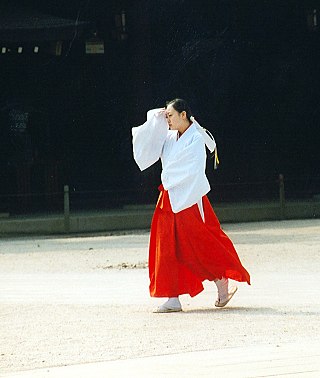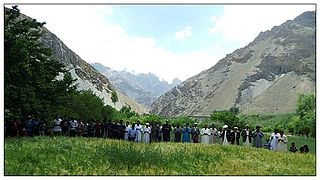Related Research Articles

Shamanism or samanism is a religious practice that involves a practitioner interacting with the spirit world through altered states of consciousness, such as trance. The goal of this is usually to direct spirits or spiritual energies into the physical world for the purpose of healing, divination, or to aid human beings in some other way.

Spirit possession is an unusual or an altered state of consciousness and associated behaviors which are purportedly caused by the control of a human body by spirits, ghosts, demons, angels, or gods. The concept of spirit possession exists in many cultures and religions, including Buddhism, Christianity, Haitian Vodou, Dominican 21 Divisions, Hinduism, Islam, Wicca, and Southeast Asian, African, and Native American traditions. Depending on the cultural context in which it is found, possession may be considered voluntary or involuntary and may be considered to have beneficial or detrimental effects on the host. In a 1969 study funded by the National Institute of Mental Health, spirit possession beliefs were found to exist in 74% of a sample of 488 societies in all parts of the world, with the highest numbers of believing societies in Pacific cultures and the lowest incidence among Native Americans of both North and South America. As Pentecostal and Charismatic Christian churches move into both African and Oceanic areas, a merger of belief can take place, with demons becoming representative of the "old" indigenous religions, which the Christian ministers attempt to exorcise.

In European folklore of the medieval and early modern periods, familiars were believed to be supernatural entities or spiritual guardians that would protect or assist witches and cunning folk in their practice of magic. According to records of the time, those alleging to have had contact with familiar spirits reported that they could manifest as numerous forms, usually as an animal, but sometimes as a human or humanoid figure, and were described as "clearly defined, three-dimensional... forms, vivid with colour and animated with movement and sound", as opposed to descriptions of ghosts with their "smoky, undefined form[s]".

A miko, or shrine maiden, is a young priestess who works at a Shinto shrine. Miko were once likely seen as shamans, but are understood in modern Japanese culture to be an institutionalized role in daily life, trained to perform tasks, ranging from sacred cleansing to performing the sacred Kagura dance.

Felicitas D. Goodman was an American linguist and anthropologist. She was a highly regarded expert in linguistics and anthropology and researched and explored Ecstatic Trance Postures for many years. She studied the phenomenon of "speaking in tongues" in Pentecostal congregations in Mexico. She is the author of such well-received books as Speaking in Tongues and Where the Spirits Ride the Wind: Trance Journeys and Other Ecstatic Experiences. Her work has been published mostly in the United States and Germany.

The Burusho, or Brusho, also known as the Hunzukuch, are an ethnolinguistic group indigenous to the Yasin, Hunza, Nagar, and other valleys of Gilgit–Baltistan in northern Pakistan, with a tiny minority of around 350 Burusho people residing in Jammu and Kashmir, India. Their language, Burushaski, has been classified as a language isolate.

Shamanism is practiced in Ayyavazhi, a Hindu denomination predominantly found in South India. According to Ayyavazhi practitioners, it has been practiced since the period of Lord Vaikundar. At present certain people who are considered to be posed by the divine power use to perform shamanism in many Ayyavazhi worship centers. Though a whole acceptance from the followers in not there for this practise, several followers accept this. They claim that this practise was based on quotes on scriptures such as "to convey certain messages to the ordinary folk." Some also believe that through the words of these possessed persons one could be able to know what God tells about him or herself or their activities.

Ecstatic dance is a form of dance in which the dancers, sometimes without the need to follow specific steps, abandon themselves to the rhythm and move freely as the music takes them, leading to trance and a feeling of ecstasy. The effects of ecstatic dance begin with ecstasy itself, which may be experienced in differing degrees. Dancers are described as feeling connected to others, and to their own emotions. The dance serves as a form of meditation, helping people to cope with stress and to attain serenity.
Shamanism in various cultures shows great diversity. In some cultures, shamanic music may intentionally mimic natural sounds, sometimes with onomatopoeia. Imitation of natural sounds may also serve other functions not necessarily related to shamanism, such as luring in the hunt; and entertainment.

The Mystery of the Yeti is a Goa trance concept album conceived and arranged by Ron Rothfield. It was collaboratively produced by Raja Ram and Graham Wood of The Infinity Project; Stéphane Holweck, Loïc Van Poucke, and Serge Souque ; and Simon Posford.

Shamanic Music is ritualistic music used in religious and spiritual ceremonies associated with the practice of shamanism. korean shamanismhas a special role in folk music. Shamanic music makes use of various means of producing music, with an emphasis on voice and rhythm. It can vary based on cultural, geographic, and religious influences. The hereditary mudang families have been long committed to music and created a traditional musician-priest proficiency since its origin,in the era of the three kingdoms

Trance is a state of semi-consciousness in which a person is not self-aware and is either altogether unresponsive to external stimuli or is selectively responsive in following the directions of the person who has induced the trance. Trance states may occur involuntarily and unbidden.

Shamanism among Alaska Natives was particularly important as it served to construct their special connection to their land, and a kinship with the animals with whom they share that land. Before the introduction of western culture and the religions that are now practiced in Alaska, there was a common spiritual connection made with the people to the land they occupied. The most common name for this connection is shamanism. Shamanism differs in every culture where it is practiced, in Alaska it is centered in the animals that are common in the area. Through the use of many myths, stories, and ceremonies these animals are personified and their spirits made tangible and in turn are deeply woven within the Native Alaska people today. It was through the shaman that the spirit world was connected to the natural world. A shaman in Alaska Native culture was a mediator, healer and the spirit worlds’ mouthpiece. Although shamanism is no longer popularly practiced, it was and continues to be the heart of the Native Alaskan people.
Ongon is a type of spirit in the shamanistic belief system of Mongolia. It is a common term in Mongol mythology. After death, all shamans become shamanic souls, ongod. Idols can be consecrated to them within three years of the shaman's death and can be placed in the home or in another locale, such as a shelter out in the open. The ongon is also the physical representation of that spirit, made by a shaman, which plays a central part in the ritual that invokes the protection of the spirit. One well-known such spirit is Dayan Deerh.
Shamanism was the dominant religion of the Jurchen people of northeast Asia and of their descendants, the Manchu people. As early as the Jin dynasty (1115–1234), the Jurchens conducted shamanic ceremonies at shrines called tangse. There were two kinds of shamans: those who entered in a trance and let themselves be possessed by the spirits, and those who conducted regular sacrifices to heaven, to a clan's ancestors, or to the clan's protective spirits.

Galloping Coroners is a Hungarian rock band active between 1975–2001, and since 2009. The band established a unique "shaman punk" or "psychedelic hardcore" sound, and is regarded as one of the most important alternative bands of the 1980s from the Eastern European block. Permanent restrictions by Hungarian authorities made worldwide tours difficult for the band, but its ecstatic concerts garnered surprising success across Western Europe. Though relatively obscure and commercially limited outside of Eastern Europe, Maximumrocknroll described the band as "equal in spirit and grit to faves like Sonic Youth or Big Black but with an identity all its own". VHK has been praised as a highly important band by Iggy Pop, Henry Rollins, Jello Biafra and Einstürzende Neubauten.

Mu (Korean: 무) is the Korean term for a shaman in Korean shamanism. Korean shamans hold rituals called gut for the welfare of the individuals and the society.
A Korean traditional funeral features Korean Confucianism as well as centuries of indigenous Shamanism. Numerous anthropological scholars have attempted to discern which practices come from Shamanistic roots, and which are more purely Confucian.

Ginani is an annual crop harvesting festival celebrated in valleys of Hunza and Nagar, Pakistan. It takes place on the 21st of June—the longest day of the year.
Shamanism is a religious practice present in various cultures and religions around the world. Shamanism takes on many different forms, which vary greatly by region and culture and are shaped by the distinct histories of its practitioners.
References
- ↑ "Shamanism: Spirits in the valley - The Express Tribune". 2010-10-14. Retrieved 2016-08-06.
- 1 2 László, Csáji (2011). "Flying with the Vanishing Fairies:Typology of the ShamanisticTraditions of the Hunza". Anthropology of Consciousness. 22 (2).
- ↑ Sidky, M.H. (1994). "Shamans and Mountain Spirits in Hunza". Asian Folklore Studies. 53.